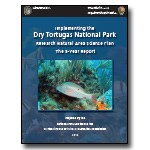|
Dry Tortugas National Park lies at the farthest end of the Florida Keys, closer to Cuba than to the American mainland. To reach this remote ocean wilderness one must travel by boat or plane over nearly 70 miles of open sea. The park is home to historical and natural wonders above and below the water's surface and has long been an inspiration to visitors. 
Animals
Corals, reef fish, birds, and sea turtles make Dry Tortugas a vibrant, one-of-a-kind haven for snorkelers and wildlife lovers. 
Plants
Dry Tortugas’ islands host native Caribbean flora, while larger keys like Garden and Loggerhead hold more exotic species due to past use. 
Environmental Factors
Formed from marine remnants, Dry Tortugas’ shifting sandy keys mark the far end of the Florida Keys, shaped by nature and humans alike. 
Research
The 46-sq-mile Research Natural Area protects Dry Tortugas’ marine life, offering a no-take zone for wildlife, snorkelers, and researchers. 
Research Natural Area 5-Year Report |
Last updated: June 9, 2025
